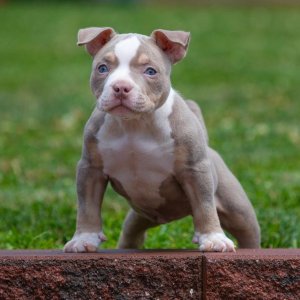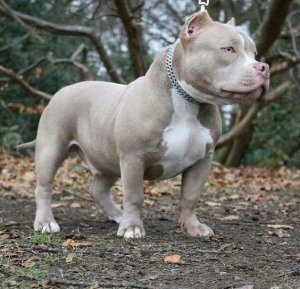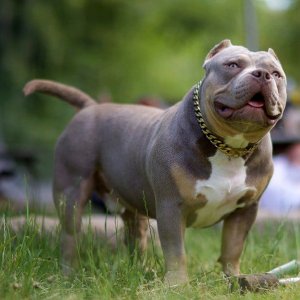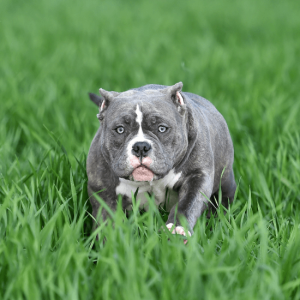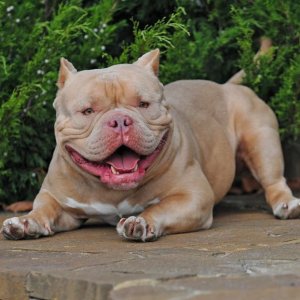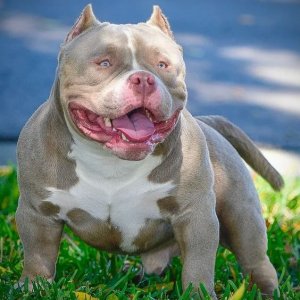Pocket Bully
What is an American Pocket Bully?
The American Pocket Bully is a relatively new breed of dog that emerged within the last few decades as a smaller, more compact offshoot of the beloved American Pit Bull Terrier and American Staffordshire Terrier.
Sometimes referred to by nicknames like “micro bully” or “mini bully,” this muscular yet petite bully dog breed was developed through meticulous crossbreeding to create the perfect pint-sized companion dog.
For prospective owners captivated by their stocky stature and loyal temperament, it’s essential to thoroughly research and understand the American Bully Pocket breed before making the long-term commitment of welcoming one into your apartment living.
Let’s start from the beginning and explore what makes this relatively new designer breed so unique and appealing for the proper owner.
A Brief History of Pocket Bully Origins and Development
While they’ve grown rapidly in popularity in recent years, Pocket Bullies, as we know them today, are a relatively new mixed breed developed within just the past few decades.
Experimental Beginnings
The origins of Pocket Bullies can be traced back primarily to the 1990s when innovative breeders, especially in the United States, began intentionally crossbreeding smaller dog breeds with the American Pit Bull Terrier and occasionally the American Staffordshire Terrier.
Some of the most common smaller dog breeds utilized to help downsize the Pit Bull-type progenitors included:
- Patterdale Terriers
- French Bulldogs
- Boston Terriers
- English Bulldogs
- Olde English Bulldogges
The overarching goal was to successfully combine the athletic physique, energy, loyalty, and working temperament of classic bully breeds like the APBT with the more compact size of sturdy “pocket” companions.
Pioneering Influences
Several pioneering breeders are credited with laying the early foundations for what would become today’s American Bully and the smaller Pocket variety.
Most notably, Lisa Shaffer, Gina Burgos, and Ken Scruton played pivotal roles through their careful selective breeding programs starting in the 1980s and 90s.
Other prominent early influencers helping establish and standardize the mini Pocket Bully in the 2000s included Jason Hinkle, Marco Avila, Henry Guevara, Shanna Guevara, and Sam Lucciarelli.
Achieving Consistency
This novel mix-and-match breeding initially resulted in very inconsistent litters, with great variability in physical traits as well as health and temperament.
However, over generations of breeding only the best examples exhibiting ideal qualities, dedicated breeders were finally able to achieve a primarily uniform dog that reliably produced “true.”
Several niche breed registries also emerged to guide ideal standards along with promotion and record-keeping.
While their origins may seem murky compared to ancient breeds, when bred responsibly the mini Pocket Bully has proven itself a fantastic companion animal.
Pocket Bully Size: Just How Small Are Mini Bullies?

One of the distinguishing characteristics setting Pocket Bullies apart from their larger Standard and XL Bully counterparts is their petite stature. But just how petite is a “Pocket” size bully?
Official Size Guidelines
According to the American Bully Kennel Club (ABKC), the official size range for the Pocket variety is:
- Height – Ideally 13” to 17” at the shoulder/withers
- Weight – Ideally 30 to 60 lbs
There is occasionally slight variation among other Bully-specific registries, but this general size range is considered standard for male and female Pocket Bully reaching full maturity.
Micro Pocket Bully
Some kennels use names like “Micro Bully” or “Pocket Micro Bully” to market Bullies at the very smallest end of the spectrum or even slightly below the ideal 13” minimum height.
However, it’s debatable whether these ultra-compact specimens should be considered truly standard Pocket Bullies according to most accepted size parameters.
If seeking a smaller Pocket, be sure to clarify size expectations with any breeder using subjective descriptors like “mini”, “tiny”, “teacup” or “micro.”
The Pocket Bully is already the smallest variety of the American Bully dog breed. So further downsizing comes with many health and structural risks.
Growth Timeline
Keep in mind that bully breeds often grow and fill out well into maturity. Don’t be alarmed if your Pocket Bully pup is lankier than expected during the juvenile growth phase.
Their full muscle mass and structure will develop with proper nutrition and exercise as they reach adulthood around age 2.
Pocket Bully Appearance: Physical Features and Attributes
In addition to their pint-sized proportions compared to other American Bully lines, Pocket Bullies also have some distinct physical features and attributes.
Compact, Muscular Build
The ideal Pocket Bully dog features a compact yet very muscular, athletic body. They boast a broad chest, well-defined hindquarters, and an overall square, powerful appearance.
In terms of build, balance, and body type, the Pocket Bully dog should resemble a smaller yet equally impressive edition of the Standard American Bully.
Blocky Head
The head of the Pocket Bully dog is characteristically large and broad with a very blocky, square skull shape.
Prominent cheek muscles give the face a “ripped” look while a wide jaw and deep muzzle provide strength.
Facial Features and Expression
Pocket Bullies have a short muzzle with a good width to the nostrils. Their eyes are round and set widely.
Ears may be cropped or uncropped based on personal preference, as either style is acceptable.
The quintessential Pocket Bully face combines strength, confidence, and good-natured keenness.
Coat Types and Markings
The Pocket Bully sports a short, glossy, smooth coat ranging from fine to thick.
No specific colors or patterns are considered “rare” or more valuable. Pocket Bullies display an array of diverse coat colors and combinations including:
- Black
- Blue/Grey
- Chocolate Brown
- Red
- Fawn
- White
- Merle
- Tricolor
- Brindle
- Black & White
- Grey & White
Overall, their sleek, flashy coats are relatively easy to groom and maintain compared to other breeds.
General Health and Known Issues in Pocket Bullies
Despite their genetic ties to Pit Bulls, well-bred Pocket Bullies generally enjoy better health than extremely large or tiny dogs thanks to a more moderate size. However, like any breed, there are some health issues current and prospective owners should be aware of.
Orthopedic Conditions
- Hip Dysplasia – Malformation of hip joint causing osteoarthritis
- Elbow Dysplasia – Abnormal elbow joint development leading to lameness
- Patellar Luxation – Kneecap dislocation
Reputable breeders screen breeding dogs using OFA or PennHIP certifications to minimize the passing on of inheritable orthopedic diseases.
Congenital Conditions
- Heart murmurs or defects – Screened by veterinary cardiologist evaluation
- Cleft lip/palate – Opening in roof of mouth or lip
Dogs found to have these congenital conditions should not be bred.
Allergies and Skin Issues
- Demodectic Mange – Caused by mite infestation
- Food Allergies – Reaction to ingredients like chicken, wheat, corn
- Skin Infections – Bacterial or fungal
Daily omega supplements along with a high-quality diet and skin care regime help minimize allergies and skin issues in most Pocket Bullies.
Brachycephaly Health Risks
The Pocket Bully’s shorter muzzle and blocky head shape do come with potential respiratory issues including:
- Elongated soft palate – Obstructs airway
- Stenotic nares – Pinched nostrils
- Everted laryngeal saccules – Throat tissue obstruction
Owners of Pocket Bullies with severely brachycephalic “smushed” facial features should monitor for respiratory distress, especially in warmer or more humid environments. Surgery can correct certain anatomical abnormalities.
Lifespan
With responsible breeding, proper preventative care, exercise, socialization, high-quality nutrition, and an attentive owner, a Pocket Bully can enjoy a long, healthy, vibrant life of 10-13 years or longer.
Pocket Bully Temperament: Personality Traits and Behavior Overview
More so than merely their exterior features, the hallmark of any great dog is an outstanding temperament. So what can prospective Pocket Bully owners expect in terms of personality, traits, and behavior tendencies?
Intelligent and Trainable
The Pocket Bully is considered a medium-sized dog that is a highly intelligent, receptive, luxury breed that generally exhibits a strong eagerness to please their owner and responds well to training and structure from an early age.
Their energetic nature paired with an innate yearning for human interaction allows Pocket Bullies to thrive when provided proper outlets for stimulation and bonding.
Affectionate Goofballs
Regardless of their brawny, tough-looking exterior, properly bred, socialized Pocket Bullies are extremely loving, sweet-natured, comical dogs.
They form intensely loyal bonds with family and will enthusiastically shower their favorite people with puppy kisses at every chance. You’re guaranteed to have a shadow trailing your every step!
Active Yet Adaptable
While they require a committed owner able and willing to provide adequate outlets for regular exercise and mental stimulation, Pocket Bullies are quite adaptive dogs.
Unlike some other high-energy breeds prone to neuroticism or destructive behaviors if under-exercised, Pocket Bullies tend to take life in stride as long as their basic needs are met through routine and interaction.
Kid and Pet-Friendly
Thanks to their affable, tolerant attitude, Pocket Bullies generally excel in homes with children, other dogs, and various household pets when properly introduced and supervised.
Their smaller stature makes them less prone to accidentally knocking over toddlers compared to larger breeds. And their playful nature enjoys the antics of kids.
Potential Challenges
No breed is perfect, and without proper structure, leadership, training, and socialization from a young age, Pocket Bullies can develop some negative behavioral tendencies including:
- Dog aggression – Especially same-sex aggression
- Separation anxiety and destruction
- Wariness or fearfulness of strangers
- Stubbornness or dominance issues
However, the majority of undesirable behaviors can be mitigated by a pet owner committed to proper handling, management, and training.
The ideal Pocket Bully temperament is happy, confident, biddable, and always eager for the next adventure with their beloved people.
Exercise Needs and Activity Guidelines
While their compact size may be deceiving, make no mistake – Pocket Bullies are energetic, athletic dogs requiring a committed outlet for daily physical and mental exercise.
Exercise Duration
Most Pocket Bullies need 30-60 minutes of vigorous activity per day. This can be achieved through:
- Brisk walks or jogging
- Playing games of fetch
- Interactive toys and puzzles
- Off-leash running in safe enclosed areas
Additionally, they greatly benefit from regular opportunities to run and play off-leash in a securely fenced backyard if possible.
Activity Type Preferences
Thanks to their athletic lineage, Pocket Bullies tend to excel at and thoroughly enjoy:
- Agility obstacles and drills
- Hiking and trail adventures
- Swimming – often a favorite!
- Fetching balls, discs, sticks
- Tug-of-war games
- Learning new tricks
Mental stimulation through training sessions and food puzzle toys is also essential to prevent boredom.
Strengths and Weaknesses
Their stocky build allows Pocket Bullies to keep up on hikes and outdoor excursions better than some stubbier breeds.
However, their brachycephalic facial structure can make them prone to overheating on extremely hot, humid days. Careful monitoring and access to water and shade is crucial.
Providing your Pocket Bully with adequate outlets for their energy each day will keep them fit, content, and less likely to develop problem behaviors.
Nutrition Tips and Dietary Needs
Proper nutrition is vital for any breed, but especially active, athletic dogs like the Pocket Bully to support healthy muscle development and joint health.
High-Quality Protein Sources
Pocket Bully require a protein-packed diet with ingredients like:
- Chicken
- Beef
- Fish
- Eggs
Some do well on a rotational diet switching proteins periodically. Avoid corn, wheat, and soy.
Caloric Needs
Since Pocket Bully can be prone to obesity if overfed, follow feeding guidelines based on your individual dog’s age, activity level, and metabolism.
Puppies have higher calorie requirements for growth. Adults need portion-controlled meals tailored to their energy expenditure.
Supplement Recommendations
Glucosamine, chondroitin, and omega fatty acid supplements support joint, skin, coat, and overall health. Probiotics aid digestion.
Always consult your veterinarian before starting supplements. Only purchase reputable pet supplement brands.
Potential Allergies
If signs of food allergies arise such as itching, ear infections, or skin issues, try an elimination diet under the guidance of your vet. Common triggers include chicken, beef, dairy, and grains.
Monitor treat consumption as well.
With proper nutrition matched to your Pocket Bully’s needs and quirks, they’ll thrive at a lean, fit, healthy weight their joints can support.
Grooming Requirements and Care Essentials
One of the perks of the Pocket Bully breed is they have relatively minimal grooming requirements compared to thick-coated or continuously shedding breeds. But there are still some important care needs.
Coat Upkeep
The Pocket Bully’s short, sleek coat requires only occasional brushing, more frequently during seasonal shedding periods. Use a rubber curry brush to distribute oils.
Bathe only when truly needed using a mild shampoo. Over-bathing strips healthy oils.
Nail Maintenance
Trim nails at least monthly to prevent cracking, infection, or overgrowth. Use clippers suitable for thick nails and styptic powder in case of bleeding. Introducing nail handling in puppyhood.
Ear Cleaning
Gently wipe inside ears weekly with cleaning solution and cotton balls to prevent waxy buildup and moisture that fosters yeast and bacteria. Never insert cotton swabs into the ear canal.
Oral Care
Brush teeth using an enzymatic dog toothpaste 2-3 times per week and provide chews and toys that polish teeth. Schedule annual dental cleanings.
Skin Fold Care
For Pocket Bully with heavier wrinkles, gently cleanse facial folds 1-2 times per week using warm water and dry thoroughly to prevent moisture, irritation, and infection.
With a proper grooming routine, your Pocket Bully’s coat, skin, ears, nails, and teeth will stay clean and healthy. Always reward and praise them during handling.
Bringing Home a Pocket Bully Puppy
For many new Pocket Bully owners, the journey starts with bringing home an adorable Pocket Bully puppy. Here are some tips to be prepared for the exciting puppy years.
Puppy-Proofing Your Home
Pocket Bully puppies are energetic, mischievous explorers! Remove any toxic substances, dangerous objects, and valuables out of reach. Restrict access if needed and dog-proof fences.
Scheduling Time Off
If possible, plan to take up to a week off work when your puppy first comes home. This lets you focus fully on transitioning them into their new environment and bonding with you.
Stock Up on Supplies
Shop for all essentials beforehand – crate, bed, bowls, collar/leash, poop bags, toys, grooming tools, enzymatic cleaner, puppy formula, etc. Better to have on hand than scramble during your first sleepless nights!
Find a Vet
Interview veterinarians in your area with experience with bully breeds to establish a relationship right away. Schedule the first puppy check-up within a few days of arrival.
Start Training Immediately
Use your first weeks at home to lay the foundation for good manners and obedience. Pocket Bully puppies are very bright and eager to learn! Use positive methods and keep it fun.
Socialize Extensively
Safely introduce your Pocket Bully puppy to new people, places, animals, surfaces, sounds, and experiences. Create positive associations to prevent future fears and anxiety.
With preparation, patience, and consistency, your pocket bully puppy will mature into an outstanding companion. Be sure to choose an ethical, health-focused breeder.
Training Overview: Best Practices For Pocket Bullies
Reputable breeders place heavy emphasis on breeding for sound temperament, but it’s still imperative Pocket Bully owners commit fully to proper socialization and training from a very young age.
Start Early With Socialization
Flood puppies with positive new experiences during the prime 8-16 week socialization period before fear imprinting sets in. Safely introduce them to a wide range of:
- People of all ages/appearances
- Other pet dogs and animals
- Environments and situations
- Noises, objects, surfaces
Use ample treats and praise to build confidence. Maintain reasonable precautions.
Positive Reinforcement Methods
The most effective training approach for Pocket Bullies utilizes positive reinforcement methods. Motivate your Bully to happily cooperate by rewarding desired behaviors with:
- High-value food treats
- Verbal/physical praise
- Their favorite toys or playtime
Keep sessions upbeat, varied, and focused. End on a high note before boredom sets in.
Obedience Foundation
Mastering basic obedience commands like sit, stay, down, heel, come, and leave, helps establish respectful communication and provides necessary impulse control.
Address Potential Issues
Target potential problem areas proactively like mouthing, nipping, jumping up, leash pulling, and any dog or people reactivity. Seek professional guidance as needed.
With a consistent yet kind approach, you can shape your Pocket Bully into a happy, obedient dog who lives to please you. Training strengthens your bond exponentially.
Pocket Bully Price: What’s the Average Cost?
One of the most common questions prospective owners have is “How much does a pocket bully cost?” Here’s an overview of the typical price range.
Purchasing a Pocket Bully Puppy
For a well-bred pocket bully puppy from health-tested, champion pedigree parents, expect to pay between $2000 – USD 5000+.
Factors influencing price from reputable breeders include:
- Coat color and markings
- Conformation and pedigree quality
- Puppy vs. older dog
- Location and demand
Be prepared for a 6-month to 2-year waitlist with top breeders. Avoid cut-rate puppy mill pups with no health screening.
Adopting a Pocket Bully
If purchasing from a breeder is not feasible, adopting an adult or adolescent pocket bully from a rescue or shelter is a more affordable option.
Adoption fees typically range from $50 – $500. The tradeoff is less predictability in size, appearance, and temperament.
Be sure to ask about medical history, past behavior issues, and temperament evaluation. Visit several times to determine fit.
Ongoing Ownership Costs
In addition to the initial pocket bully price, buyers must budget for ongoing expenses including:
- Quality dog food and treats
- Veterinary care and pet insurance
- Supplies like beds, toys, gear
- Training Classes
- Grooming costs
- Boarding fees if needed
Aim for the highest quality pup within your budget from an ethical source. Pocket bullies are a long-term commitment!
Ethical Breeding Considerations for Pocket Bullies
For those interested in responsible Pocket Bully breeding, significant research, planning, investment, and care are required to do it the right way. Here is a brief overview of best practices.
Only The Best Specimens
Carefully evaluate the structure, health testing results, pedigree, and temperament to determine breeding suitability. Only the very best representations of the breed should reproduce. There can be no compromises.
Required Health Testing
Reputable breeders submit breeding dogs for hips, elbows, heart, spine, and patella evaluation by specialist veterinarians and obtain OFA or PennHIP certification numbers.
Pedigree Study
Meticulously research pedigrees and ancestral health for generations back. Seek out optimal genetic diversity. Breed to complement strengths and weaknesses.
Careful Whelping Protocol
Once the dam is confirmed pregnant, provide attentive veterinary care and prepare an ideal whelping environment. Monitor the dam very closely leading up to and during delivery to ensure the safety of puppies. Have an emergency protocol in place if assistance is needed.
Raise Litters Properly
From birth through weaning around 8 weeks, ensure puppies receive exemplary care including regular veterinarian check-ups, deworming, socialization, and handling. Evaluate each puppy extensively.
Stringent Screening
Carefully screen prospective buyers for suitability to meet the needs of the breed. Provide lifetime breeder support and take back any dog in need. Require spay/neuter of pet-quality puppies.
Breeding dogs are an immense responsibility not to be taken lightly. But improving the breed generation by generation can be incredibly rewarding.
Finding a Healthy Pocket Bully: Breeder vs Rescue Considerations
For many seeking to add a Pocket Bully to their family, the next step is deciding on the best route – a reputable breeder or adoption/rescue. Here are some pointers for each path.
Identifying a Reputable Breeder
Seek out breeders who:
- Specialize in the breed long-term
- Prioritize health testing and pedigree research
- Prove ethical practices and devotion to the dogs
- Require spay/neuter of pet puppies
- Offer support and contract safeguards
Be prepared to wait 6 months to a few years for a puppy from the best breeders who often have long waitlists. Avoid those who breed primarily for profit or make excuses for not doing the work to better the breed.
Considering Pocket Bully Rescue
If going the adoption route, thoroughly research rescues and shelters for a good match. Be realistic and prepared for potential behavior challenges and training needs.
Adopted Pocket Bullies may come with an uncertain history and temperament challenges. But for the right adopter willing to work through any issues, adopting can be extremely rewarding.
With careful diligence, you can find a good ethical source and welcome a wonderful new canine companion into your home, whether from a breeder or rescue situation. Avoid puppy mills, pet stores, and backyard breeders at all costs.
Debunking Myths and Misconceptions About Pocket Bullies
Unfortunately, like many Pit Bull-type breeds, the Pocket Bully tends to suffer unfair stereotyping despite its sweet loyal nature when properly bred, socialized, and raised.
Aggression Myth
The assumption that Pocket bulls are inherently dangerous or aggressive dog breeds could not be further from the truth. When responsibly bred for sound temperament and appropriately handled, Pocket Bullies exhibit stellar companionship traits – loyal, affectionate, people-oriented, and eager to please.
Vicious Labeling
Attachments of terms like “vicious”, “unpredictable”, “time bomb” and more to Pocket Bullies are falsehoods rooted in irrational fear, misunderstanding, and negative bias.
In reality, Pocket Bullies are extremely sensitive dogs who crave human interaction and aim to please their owners. When treated as valued family members and provided structure through training, they thrive in home environments.
Misconceptions About Care Needs
Many inaccurate assumptions circulate that Pocket Bullies require little moderate exercise, training, or attention thanks to their compact version.
Pocket Bullies have high needs for vigorous daily exercise, mental stimulation, training, and plenty of quality time with their adored people. They are not a breed suited for neglect.
Breed Ambassadors
By adopting your Pocket Bully from an ethical source and providing exemplary care, training, and ambassadorship, you have the power to positively shift perceptions and prejudices surrounding this wonderful, loyal breed.
Be sure to adequately socialize and obedience train your Pocket Bully from puppyhood onward, and always set them up for success in any public interactions. With dedicated advocacy, their reputation can be restored over time.
Frequently Asked Questions About Pocket Bullies
Conclusion: Is the Pocket Bully the Right Breed For You?
In summary, the Pocket Bully has skyrocketed in popularity in recent years among owners attracted to their loyal, fun-loving temperament and smaller size compared to the Standard American Bullies.
When acquired through responsible breeding channels and properly cared for over their lifetime via devoted owners, Pocket Bullies can make outstanding companions and excellent family pets.
However, it’s paramount that prospective owners carefully weigh if the needs of this active, highly social breed align with their own lifestyle and commitment capabilities before deciding to add one to their family.
We hope this detailed Pocket Bully breed guide gives you a comprehensive understanding of their background, requirements, and unique qualities. Please consider all aspects carefully, and only proceed if you can make a strong commitment to providing the lifetime care, training, exercise, and veterinary needs of this special breed.
If the loyal, affectionate Pocket Bully seems like the perfect pint-sized companion for your home after learning more, we wish you the very best in finding your ideal pup or rescue bully and enjoying the memorable journey of responsible bully ownership ahead!

Mandy has lived with pitbulls her whole life, and she has amassed a wealth of experience and knowledge about these magnificent animals. Having had the pleasure of owning and caring for numerous pitbulls over the years, she has come to understand their unique characteristics, behaviors, and needs. Read more

